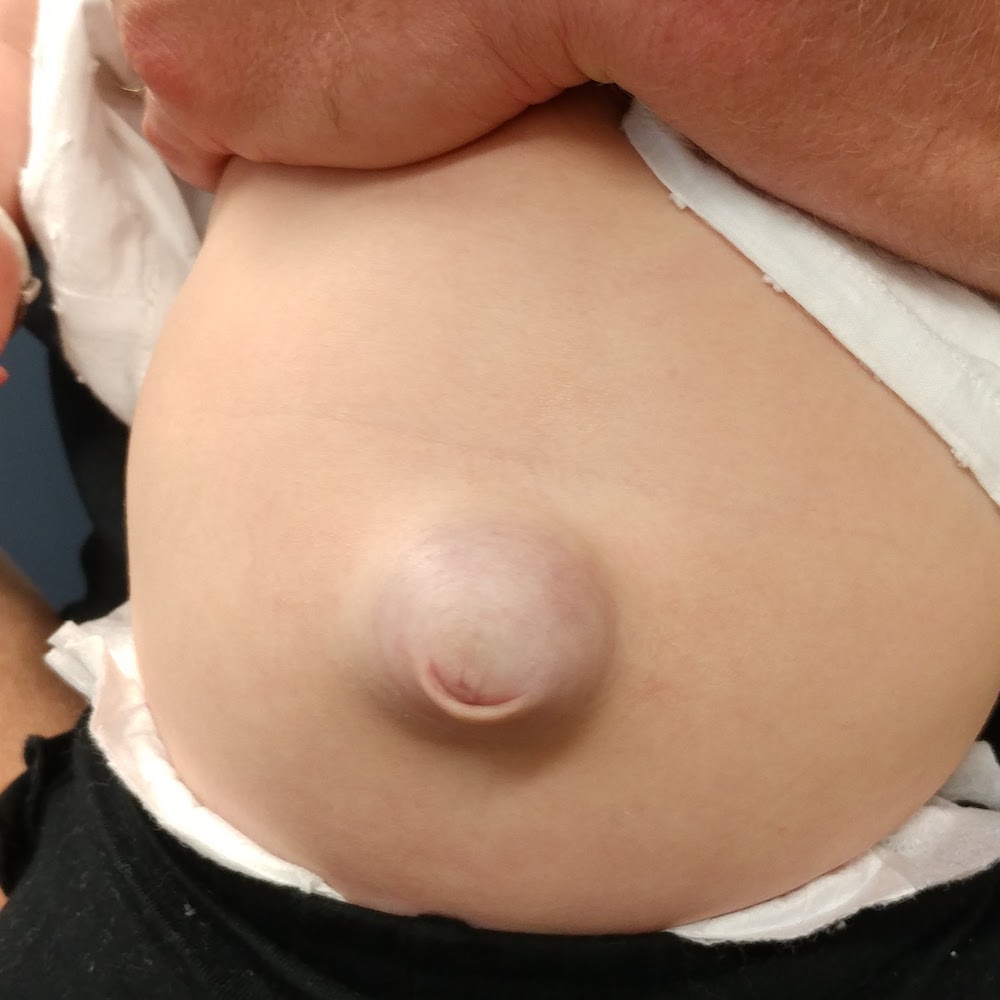Umbilical Hernia
A hernia is one of the most common surgical conditions we treat. An umbilical hernia looks like a lump in the belly button (umbilicus). This is very common and often resolves in the first year of life. See below for more detailed information.
The Condition
What is an umbilical hernia?
An umbilical hernia is a lump of the belly button (umbilicus), often related to the intestines bulging through an opening in the abdominal wall muscles, where the umbilical cord came through. The bulge can contain fat, or intestines.
Why does it occur?
There is a delay to closure of the abdominal wall muscles where the umbilical cord came through. There is no known cause for this to occur.
Often in the first 3 months it can increase is size due to straining and colic.
Does it need repair?
Not always. More than 90% of umbilical hernias resolve in the first year of life. Even in the older age groups, the defect in the muscles continue to close with age.
Is it dangerous?
Rarely. The chance of bowel getting stuck in the hernia is extremely low. The skin bulge and stretch is not dangerous, and there is still a very high chance it will resolve on its own without surgery.
If the bulge is firm, tender, becoming red, and your child is vomiting, there may be a chance the hernia is stuck. In this case, take your child to the emergency department.
Treatment
Surgical repair
A day procedure under general anaesthetic, through a small incision just below the umbilicus. The hernia is closed with sutures, and the wound is closed with dissolvable sutures. There is no mesh.
How long does the operation take?
The operation takes about 15-20 minutes.
The anaesthetic can take about the same time before and after, so you’ll be away from your child for an hour or so, until they are ready for you in the recovery room. You will be notified when they are ready for you to see them in recovery.
Should I repair it at all?
Your surgeon will speak to you about options. Sometimes there is pain, and irritation from the bulge. Repair is often considered before school age.
What are the risks of the operation?
The anaesthetic – airway and breathing issues are extremely rare
- Recurrence – about 1% for most children
- Infection -1%
- Bleeding, bruising and swelling. Usually minor
Recovery
What happens after the operation?
Recovery – you will be called into the recovery room just after they are awake.
Feeding – you can give your child a feed in the recovery room.
Home – usually after an hour or 2, once the nursing team have ensured your child is safe and comfortable
The wound / Dressings
The area will become swollen, and a little firm under the wound. This is a normal healing process and developing scar.
There is a waterproof dressing that can be removed in the bath after a week.
Baths / showers can usually resume the day after the operation.
Pain relief
Your child will receive good pain relief in the operating room, that will last a few hours.
After the operation they will need paracetamol and possibly ibuprofen (eg. Nurofen) for a few days. Please let your surgeon and anaesthetist know if your child has intolerances or allergies.
In order to avoid medication, aim to distract your child and keep their mind off the area. Reading, writing, playing board games and other engaging activities help.
Normal activity
Bath / shower – the day after the operation
Swimming – 1 week
Daycare / School – 5-7 days
Sports – 2-3 weeks
Troubleshooting
The hernia is stuck
If you notice the bulge that is not reducing any more, it may be irreducible. If it stays this way for a few hours the content (bowel) may become injured. This is called strangulation, and your child will require emergency treatment.
Try to stay calm, and take your child to the nearest children’s hospital. Do not give your child a feed, as it is safer for them to have an empty stomach. The emergency team and surgical team will look after your child.
Is there a wound infection?
Infections can develop around 2-4 days after the operation, and is a fairly uncommon issue.
The wound may be infected if there is increasing redness around the wound and tenderness. This may be associated with discharge from the wound site.
You will need to see your family doctor or call your surgeon for further advice.
It is very swollen - has it recurred?
It does become swollen after the operation, usually for a few days.
If your child has increasing pain, tenderness and vomiting associated with a similar bulge to before the operation there may be recurrence. If your child is unwell, you may need to go to the emergency department. Call your surgeon and let them know.
Otherwise see your GP and call your surgeon so your child can be assessed.
What do I look for?
You know your child best. If you have any concerns please see your family doctor or call your surgeon. The list below are issues that require medical attention.
- Increasing pain or persisting pain despite pain relief
- Increasing swelling or bulge – possible recurrence
- Fever >38.2 degrees Celsius
- Vomiting and feed intolerance
- Discharge or bleeding from the wound
- No bowel motions after 3 days
Experienced Surgeons
Over 25 years experience in paediatric surgery
Locations
Queensland and northern New South Wales
Appointments
Prioritised time for your child
Information
Conditions, procedures and aftercare
In the spirit of reconciliation we acknowledge the Traditional Custodians of country throughout Australia and their connections to land, sea and community. We pay our respect to their Elders past and present and extend that respect to all Aboriginal and Torres Strait Islander peoples.

